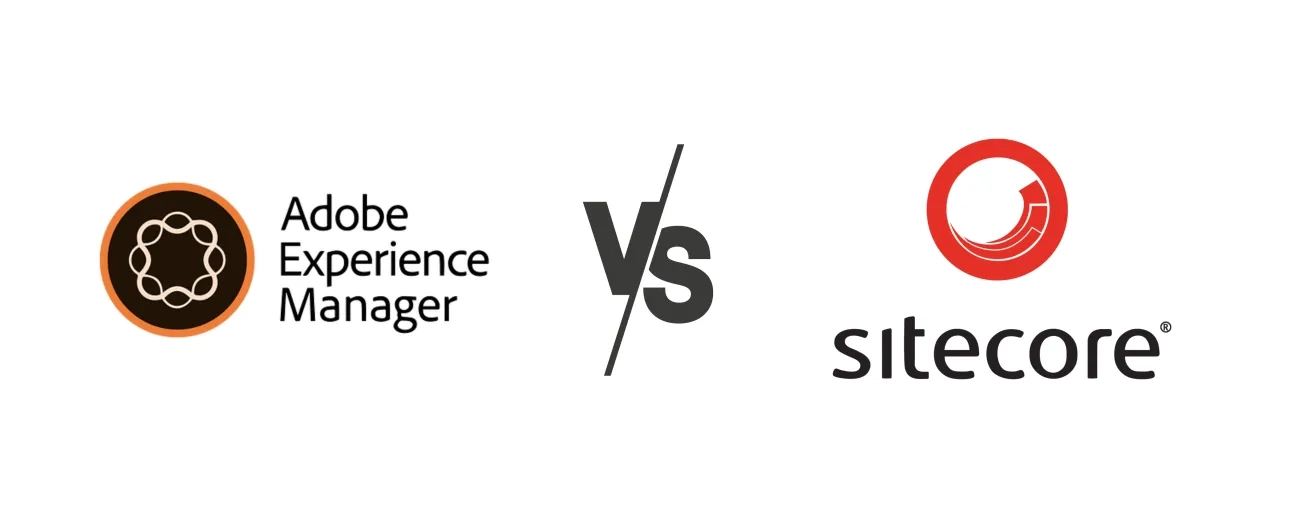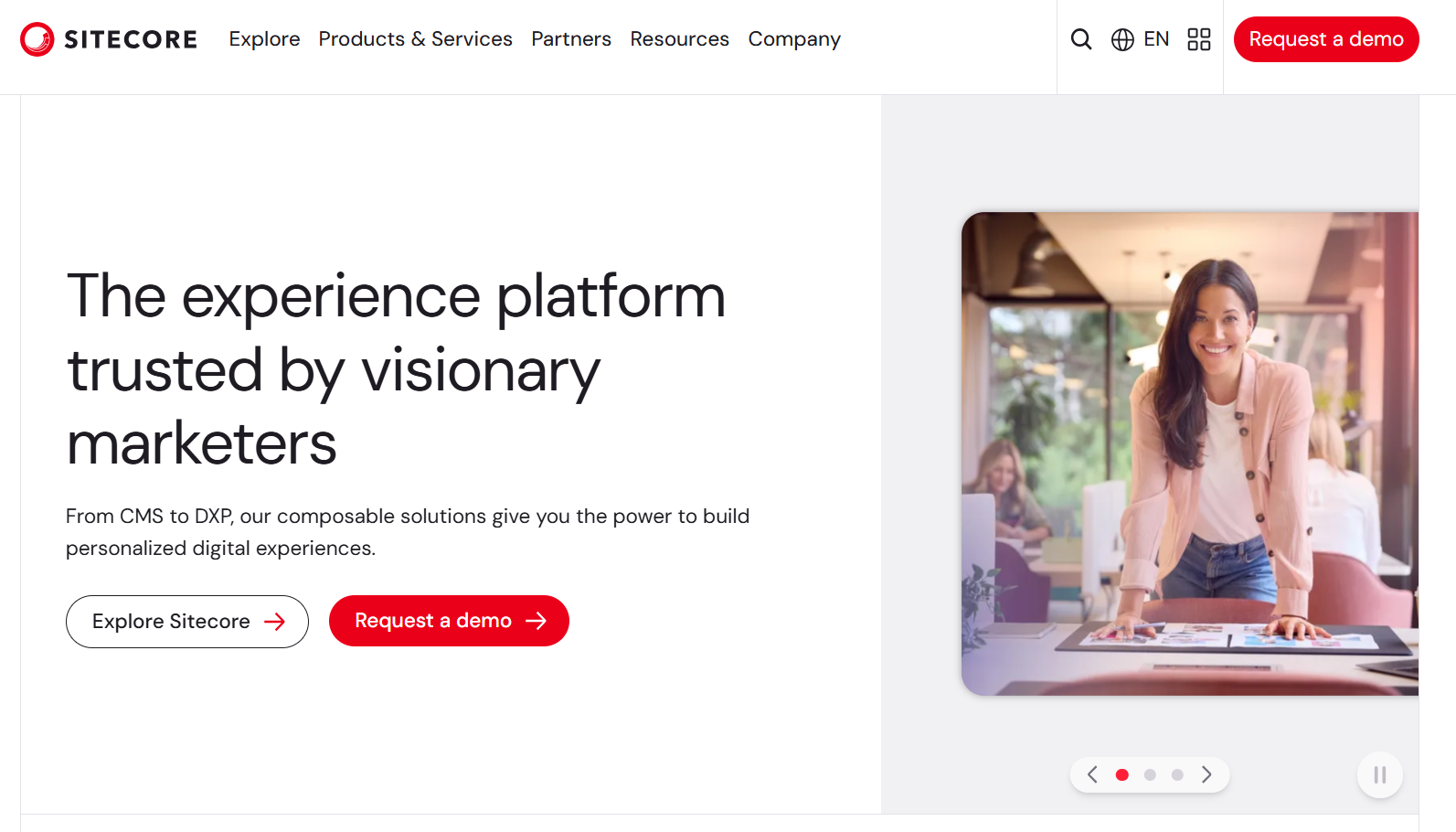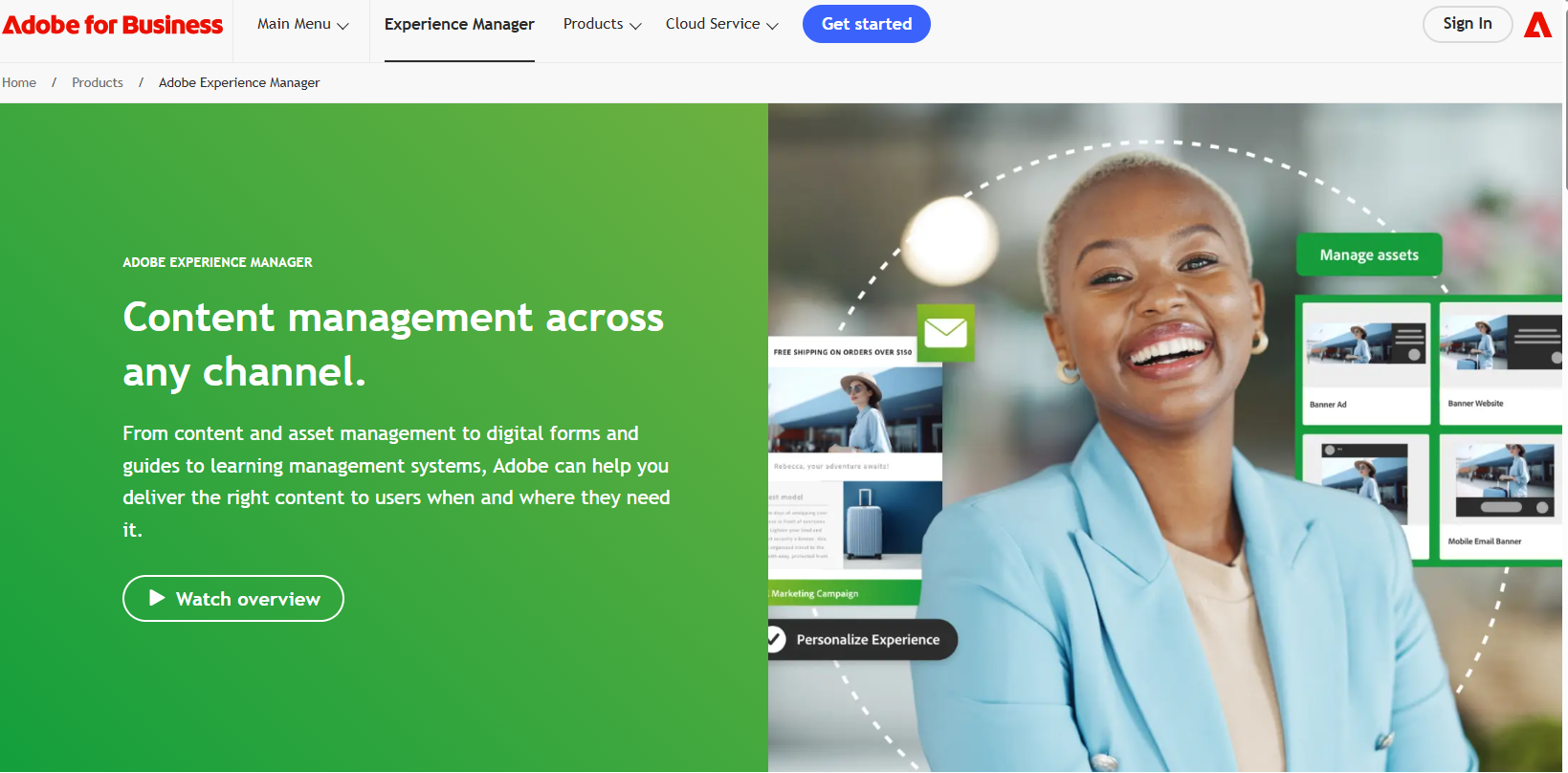
We’re excited to hear your project.
Let’s collaborate!

Sitecore and Adobe Experience Manager (AEM) are top contenders in the enterprise CMS and digital experience space. We evaluated both platforms side-by-side to understand how they differ in flexibility, ease of use, personalization, and data governance. Here’s what we found:
Sitecore is great for organizations that need deep personalization, flexible integrations, and marketing agility. It excels in composable architecture and works well for teams already using .NET or Microsoft products.
However, Sitecore’s power comes with a learning curve. While it’s more open to third-party ecosystems, it requires a strong implementation team to unlock its full potential.
In the opposite corner is Adobe Experience Manager, an enterprise-grade DXP built around Adobe’s ecosystem. It offers best-in-class asset management and deep integration with Adobe tools like Analytics, Target, and Creative Cloud.
AEM is ideal for global brands already invested in Adobe products. Its powerful features support large-scale content operations, but it can feel rigid and expensive for smaller teams or those outside the Adobe ecosystem.
We compared Sitecore vs AEM in the following areas:
We’ll review each in depth, but first, here’s a summary of our findings.
| Sitecore | AEM | |
| Pricing | Premium licenses; modular, more flexible | High enterprise cost; bundled with other Adobe services |
| Ease of use | More marketer-friendly; intuitive WYSIWYG editor | Powerful but developer-heavy; steep learning curve |
| Personalization | Real-time, out-of-the-box personalization engine | Advanced targeting via Adobe Target; requires more configuration |
| Asset management | Good DAM via Content Hub; improving fast | Best-in-class DAM with auto-tagging, smart search, version control |
Analytics & insights | Basic out of the box; enhanced with xDB and integrations | Robust reporting via Adobe Analytics; real-time data across touchpoints |
| Privacy & governance | Highly customizable; user-controlled data policies | Adobe Cloud compliance; harder to decouple or customize |
Integrations | Strong .NET ecosystem; open API | Seamless Adobe Suite integration; less open to third-party tools |
| Used by | L’Oréal, Heineken, Volvo | Microsoft, Philips, Coca-Cola |
| Best for | Agile marketing teams; composable setups | Large enterprises with Adobe stack and global teams |
“Composable, personalized experiences at scale”

Sitecore was founded in 2001 to give marketers and developers more control over digital content. Over the years, it evolved into a powerful composable DXP offering personalization, headless architecture, and full-stack marketing control.
Sitecore empowers marketers to launch personalized campaigns quickly without waiting on development. With tools like Sitecore Experience Platform and Content Hub, teams can manage content, media, and campaigns across all channels, from one place.
Its modern offerings, like Sitecore XM Cloud and OrderCloud, embrace headless and composable principles, making it easier to build modular, scalable digital experiences.
It’s ideal for brands that need flexibility, real-time personalization, and autonomy and are willing to invest in implementation and training.
“Enterprise content orchestration for the Adobe universe”

Adobe Experience Manager is part of Adobe’s Experience Cloud. It started as a CMS and evolved into a powerful DXP that seamlessly integrates with Adobe Analytics, Target, Creative Cloud, and Commerce.
AEM is built for scale. Its asset management system is one of the most powerful on the market, and its integration with Adobe Sensei enables smart tagging, auto-cropping, and AI-powered content recommendations.
But it’s not plug-and-play. AEM assumes you’re already inside Adobe’s world and willing to stay there. It works best for organizations with dedicated development teams and complex global content needs.
It’s ideal for large enterprises that value creative control, website security, and integration over ease-of-use or affordability.
In a nutshell, Sitecore is easier for marketers. AEM is more powerful but steeper to learn.
Sitecore’s interface is clean, modular, and customizable. The WYSIWYG editor and content preview features make publishing faster. Non-technical teams can create personalized landing pages and test variations without calling developers.
In contrast, AEM requires more configuration and support. It uses Java, Sling, and OSGi, great for flexibility, but not beginner-friendly. Developers often lead the implementation, while marketers need training to navigate the interface.
Still, once configured, AEM offers a unified authoring experience across channels, especially useful for multinational teams managing dozens of content versions.
Winner: Sitecore, for faster ramp-up and better marketer experience.
In a nutshell, Sitecore makes personalization easier out-of-the-box. AEM needs Adobe Target for similar capabilities.
Sitecore includes real-time personalization powered by its Experience Database (xDB). You can personalize based on behavior, goals, or engagement level, all without adding new tools. It tracks users across sessions and builds robust customer profiles.
AEM requires Adobe Target for dynamic content delivery. While Target is a powerful personalization engine, it’s an external add-on, and you’ll need to manage audience segments and tests through an additional UI.
Sitecore supports event-based triggers, A/B testing, and profile scoring with fewer dependencies. That makes it easier to deploy tailored experiences at scale.
Winner: Sitecore, for native personalization without extra complexity.
In a nutshell, AEM wins on asset management, while Sitecore holds its ground on content flexibility.
AEM Assets is arguably the most advanced DAM on the market. It integrates tightly with Creative Cloud, supports smart cropping, AI-based metadata tagging, and version control. Teams managing large volumes of assets benefit from the automation AEM brings.
Sitecore uses Content Hub, which unifies DAM, CMP, and PIM in one place. It’s API-first and cloud-native, with improving AI features. While not as mature as AEM, it’s more flexible for hybrid headless setups and third-party integrations.
For brands doing heavy creative work, AEM offers unmatched efficiency. But for multi-channel content governance and flexible data modeling, Sitecore’s modular approach may be the better fit.
Winner: AEM, for best-in-class DAM with rich creative integrations.
In a nutshell, AEM excels at enterprise reporting, but Sitecore gives more control over data sources.
AEM connects with Adobe Analytics to deliver granular insights across journeys, clicks, behaviors, conversions, and segments, all in real time. You can drill into performance per asset, per page, or per user journey.
Sitecore’s analytics engine (via xDB) tracks visitor behavior and engagement, but requires custom setup or third-party tools for advanced dashboards. It’s more flexible, but not as plug-and-play.
If your team needs rich visual dashboards and centralized analytics, Adobe’s ecosystem wins. If you want more customization and control over the data model, Sitecore gives you more room to build.
Winner: AEM, for enterprise-grade analytics and unified dashboards.
In a nutshell, Sitecore offers more control, while AEM locks you into Adobe’s governance stack.
Sitecore lets organizations build privacy models tailored to region, user role, or data type. It supports GDPR, CCPA, and enterprise-level access control through custom policy layers.
AEM inherits Adobe Cloud’s compliance and governance standards. This is great for consistency and certifications but harder to customize if your data handling needs are unique.
Both platforms meet enterprise security expectations. The difference is flexibility: Sitecore offers more freedom; AEM offers a secure walled garden.
Winner: Sitecore, for adaptable governance and data independence.
In a nutshell, Sitecore is more flexible; AEM is more expensive but integrated.
Sitecore offers a modular licensing model. You can buy only what you need (Content Hub, Experience Manager, Commerce, etc.), making it easier to phase implementation and control costs.
AEM uses a bundled licensing model and typically includes multiple Adobe products. This increases cost but streamlines procurement for companies already using Adobe Creative Cloud or Analytics.
Both platforms require implementation partners and ongoing support, which significantly adds to total cost of ownership.
Winner: Sitecore, for more granular licensing and flexible rollout.
| Platform | Pros | Cons |
| Sitecore |
|
|
| AEM |
|
|
In a nutshell, Sitecore is best for agile marketing teams building composable stacks. AEM is ideal for global enterprises already deep in Adobe’s ecosystem.
| Use Sitecore if | Use AEM if... |
You want real-time personalization without extra tools | You already use Adobe Analytics, Target, or Creative Cloud |
You value modular architecture and open APIs | You manage a high volume of creative assets and need advanced DAM |
You prefer .NET and Microsoft ecosystems | You run global content ops and need multilingual governance |
If you’ve followed this comparison closely, Sitecore comes out ahead in flexibility, personalization, and ease-of-use. But Adobe Experience Manager remains the powerhouse for teams that need scalability, asset control, and unified creative workflows.
👉 Looking for agility, composability, and personalization? Start with Sitecore.
👉 Managing global content at scale with full Adobe stack? Go with AEM.

We’re excited to hear your project.
Let’s collaborate!